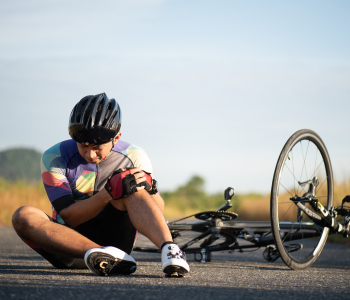Overuse Injuries
Overuse injuries occur when there is tissue damage as a result of repeated movements over a period of time.
About Overuse Injuries
Statistics & Causes.
Overuse injuries account for about 30% of all sports injuries. As is true of most injuries, the likelihood of overuse depends on the age, sport, overall health, and movement intensity of the individual. We see overuse injuries most commonly in those who participate in low-contact sports that require repeated movements or long training sessions.
More on How Overuse Injuries Occur
Overuse injuries generally occur due to errors in training. Rapid increases in time spent, frequency, or intensity of training can all contribute to acute tendinitis, stress fractures, and muscle injury. For example, a runner might increase their weekly training mileage too quickly, run too many days per week without enough rest in between, or abruptly change from flat routes to extremely hilly ones.
While any of the above have the potential to cause a disabling overuse injury, long-term overuse injuries may result in partial or even full thickness tendon tears. An example of this would be an elbow ulnar collateral ligament tear in a pitcher who pitches in too many games and practices.
A careful history taken by your physician is needed to help ascertain if overuse is the primary cause of the problem. Occasionally MRI images are needed to look for stress fractures in bone or partial/full tendon tears.
Important Considerations for Women
In females, the athletic triad is especially critical to be aware of. This consists of some level of eating disorder (which can sometimes manifest as overtraining), loss of a regular menstrual cycle, and pathologic loss of bone density that can eventually lead to early osteoporosis.
If you are a female athlete who participates in intense athletic training and you’ve noticed your unexplained loss or irregularity of your menstrual cycle, please see a physician.
Patellar Tendonitis
The patellar tendon is the connection between the thigh muscles and the tibia (also known as the shin bone). Increased activity or loading can sometimes cause inflammation of the patellar tendon, which in turn leads to pain below the patella (more commonly known as the kneecap).
For the most part, this can be resolved with rest, specific exercises, braces, and medications. Occasionally, injections of “cells” hasten the recovery. Lastly, surgery can be performed to excise the diseased tissue and stimulate healing.

Rotator Cuff Tendonitis
The rotator cuff is a conglomerate of the small muscles that surround the shoulder. This group of small muscles works together to help power the shoulder joint. Disfunction changes the mechanics of the joint, leading to severe pain.
Often, rotator cuff pain can be treated with nonoperative care, including injections, therapy, and medicines. Occasionally, the rotator cuff tendon can tear. In that case, surgical repair can become necessary.
Elbow Tendonitis
Overuse of the upper extremity can often result in pain in the elbow. This can occur both medially and laterally, with lateral being most common. Medial pain is at the inner part of the elbow, where the elbow touches the body, and lateral pain occurs on the outside. The layman’s term for elbow tendonitis is tennis elbow, even though most lateral elbow pain occurs in non-tennis players.
There are several nonoperative modalities used to cure the pain caused by elbow tendonitis. This includes injections, bracing, physical therapy, and medication regimens. When surgery is needed, fortunately it is usually curative while minimally-invasive.
Treatment of Overuse Injuries
Treatment of the vast majority of overuse injuries requires some level of relative rest – this is generally defined as doing less than you were doing before. That could mean mildly cutting back on a training program, completely stopping training, or even the use of crutches or a sling to allow healing.
There are rare instances that may require surgical intervention, such as elbow ligament reconstruction, or some types of stress fractures in the hip or tibia that need a metal rod or screws. Left untreated, certain overuse injuries can result in serious harm – as a general rule, it’s best to consult with an experienced physician.



